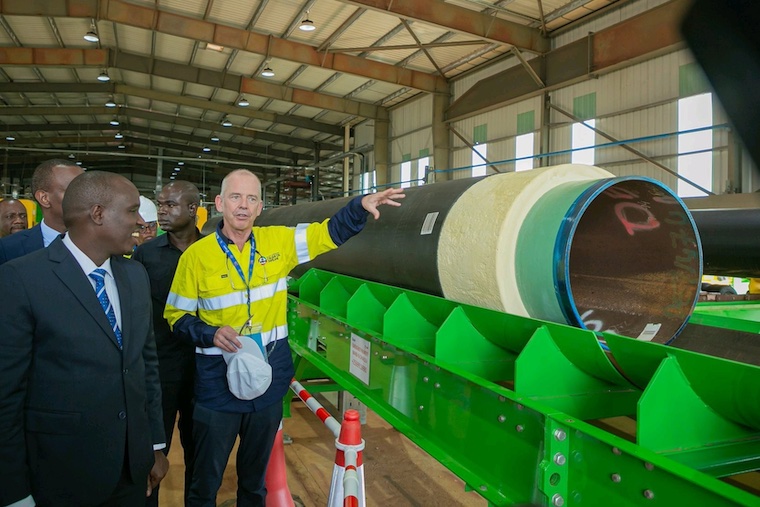Uganda, Tanzania agree on new route for gas pipeline
A new route for the proposed gas pipeline from Tanzania to Uganda will form part of the discussions between the two countries when the project’s feasibility study is done, a departure from the earlier suggestion of laying the pipes parallel to the East African Crude Oil pipeline.
Ruth Nankabirwa, Uganda’s minister of Energy and Mineral Development, says the two countries have agreed to lay the gas pipes closer to communities to ease access to the product. Earlier proposals had suggested that since nearly all the land for the 1,443km East African crude oil pipeline had been acquired, it would only make sense if the gas pipes were laid side by side in the same corridor.
This, it was assumed, would relieve the two countries the tedious process of looking for other pieces of land, the huge financial implications that come with compensation hurdles, and reduce the time to build the gas pipeline. But after much thought, the two states have agreed that finding a new route would make economic sense.
“We thought initially that we were going to use the East African Crude Oil Pipeline (EACOP) space and that it was going to be easy. However, the Tanzanian government rightly changed the course of the route because this gas is a finished product, which is needed; so, it cannot bypass communities along the way,” Nankabirwa told Deep Earth in an exclusive interview on the sidelines of the Africa Mining Indaba in Cape Town recently.
Nankabirwa could not tell when the feasibility study for the Tanzania-Uganda gas pipeline would be completed. She, however, said that the two countries recently instituted two committees – steering and technical – in Dodoma, Tanzania, and assigned them to start on the feasibility study. The study will inform how much gas needs to be piped to Uganda.
Tanzania has nearly 50 trillion cubic feet of gas that it is exploring, which is more than enough to power the entire country and supply more to neighbouring countries. In Uganda, TotalEnergies and Cnooc – the operators of the Tilenga and Kingfisher oil fields respectively– intend to develop gas facilities. Uganda has an estimated 500 billion cubic feet of gas.
This gas, which is expected to be depleted in just eight years, will be used to mainly power the different project infrastructure such as the central processing facilities, the flowlines and the crude export pipeline to Tanzania, among others. A small amount of this gas will be converted into liquefied petroleum gas for domestic consumption.
Many homes in Uganda still use charcoal, which accounts for most of their energy needs. The use of charcoal has placed pressure on Uganda’s forest cover. Official figures place the loss of 72,000 hectares of forest cover annually on firewood and charcoal. This is equivalent to 100,000 football pitches, according to Uganda’s Energy Transition Plan.
Shifting many of these homes to the use of gas is being seen as of paramount importance. It is not the first time that Uganda and Tanzania have discussed plans to build a gas pipeline. Tanzania’s government told Uganda about its interest to sell some of its large quantities of gas to neighbouring countries nearly 10 years ago.
Whispers within the corridors of power offered the view that this was not just about Tanzania selling gas, but a give-and-take condition for participating in Uganda’s oil project through acquisition of stakes in, majorly, the proposed oil refinery. In 2018, the two countries signed a memorandum of understanding to build a gas pipeline, which would run parrel to the proposed East African Crude Oil Pipeline.
The signing of this MoU offered hope to Uganda’s plans of building its first direct-reduced iron (DRI) plants that will use mostly gas – a healthier form of producing steel without the use of the conventional blast furnace that many environmentalists balk at.
Traditionally, many steel companies in Uganda today are using heavy fuel oil and coal for heating iron ore. Other than the high importation costs for these two energy sources, environmental activists continue to criticise the use of heavy fuel oil and coal due to their high carbon emissions, which are responsible for drastic weather changes such as floods and droughts.
Uganda’s Energy Transition Plan – a blueprint that will guide Uganda to zero carbon emissions by the year 2065 – which was launched in December 2023 during the COP 28 summit in Dubai, UAE, offered a clearer picture of the complexity of building clean DRI plants.
The plan talks of how Uganda, in an effort to reduce the cost of importing heavy fuel oil and coal for steel plants, built two direct-reduced iron plants in Iganga district, which are operated by Tembo Ltd, and another in Masese, operated by Abyssinia Iron and Steel Ltd. While the report said these two plants do not require coal for their operations, it added that they have high emissions.
The Energy Transition Plan adds that after 2030, many steel plants using coal will be phased out in preference for those using gas. That deadline only adds to the pressure for both Uganda and Tanzania to quickly resolve some of the most critical issues for the gas pipeline to be built, one of which will be the route.
In January 2020, the National Planning Authority, with support from the European Commission, released an interesting gas demand report, which offered certain specifics on where exactly a more practical gas pipeline should be routed.
With the proposed construction of a DRI plant in Kabirizi in the western Ugandan district of Rubanda, the report suggests that a gas pipeline from Tanzania should go through the border point of Mutukula, move towards Mbarara industrial park, continue to Rubanda, before also supplying the Kabale industrial park.
Another pipeline can also be routed to the Masaka industrial park before it connects to the existing Bweyogerere, Luweero, Luzira and Jinja industrial parks. Whichever way the gas pipeline is channeled, one thing is clear: Uganda needs it urgently if it is to meet its carbon emission reduction targets.

